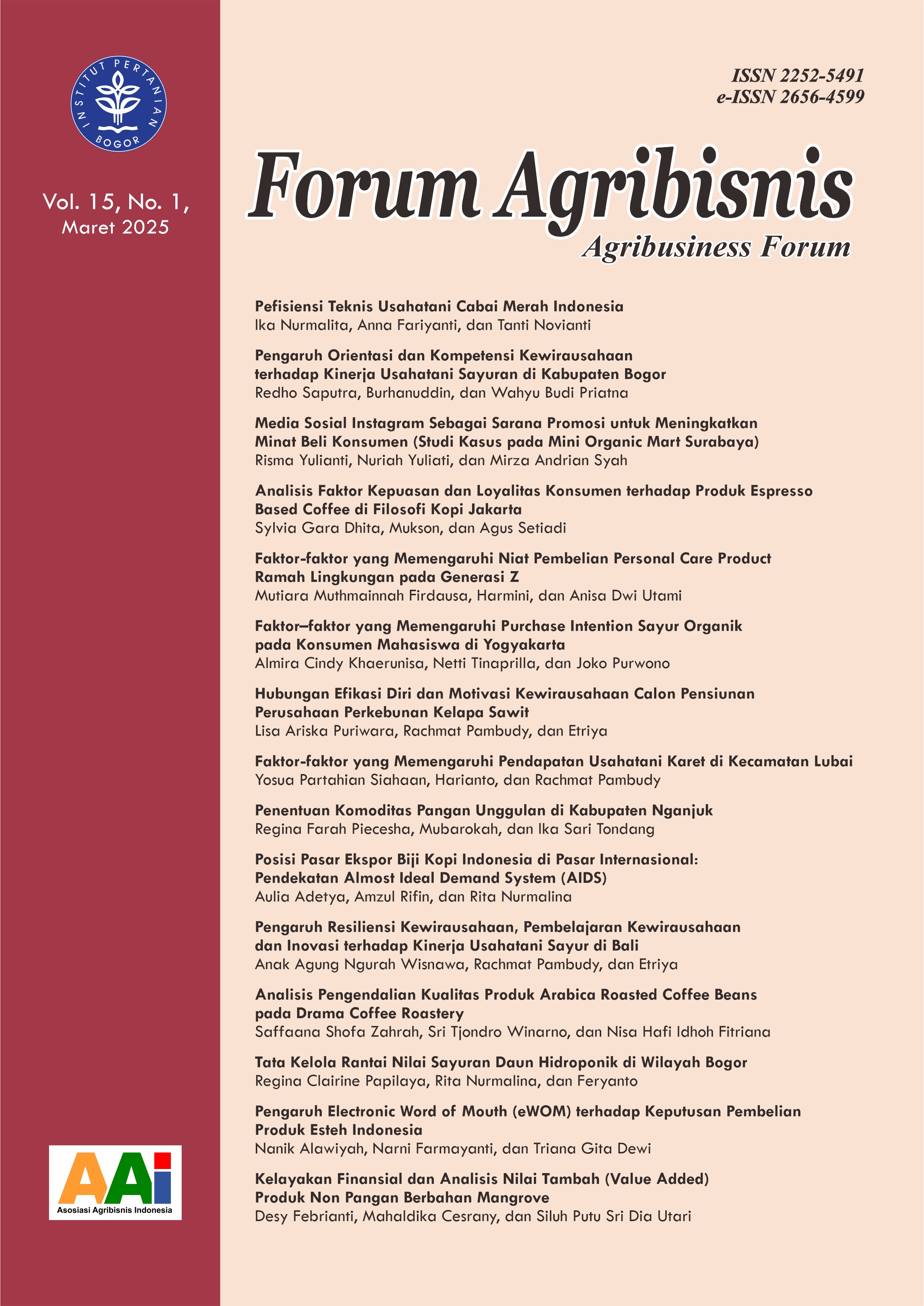Tata Kelola Rantai Nilai Sayuran Daun Hidroponik Di Wilayah Bogor
Main Article Content
Abstract
Value chain governance within hydroponic systems plays a critical role in optimizing every stage, from product design to marketing. This study aims to analyze the governance structure established in the value chain of hydroponic leaf vegetables. Primary data were collected through structured interviews using questionnaires and field observations. The sampling method employed was snowball sampling, involving a total of 9 farmers, 2 collectors, and 1 retailer as respondents. Data analysis was conducted qualitatively using a descriptive approach, referring to the value chain analysis framework proposed by Kaplinsky. The findings reveal that the type of governance in the hydroponic leaf vegetable value chain in Bogor Regency is categorized as modular governance. This governance type reflects a high degree of independence among actors within the value chain, coupled with strong coordination and adherence to established standards. These results provide insights into the efficiency and adaptability of modular governance in supporting sustainable and technologically driven agricultural practices.
Downloads
Article Details

This work is licensed under a Creative Commons Attribution-ShareAlike 4.0 International License.
The author submitting the manuscript must understand and agree that the copyright of the article manuscript must be submitted/transferred to the Journal Forum Agribisnis. This work is licensed under the Creative Commons Attribution-ShareAlike 4.0 (CC BY-SA) International License in which the Author and Reader can copy and redistribute the material in any media or format, and remix, modify and build material for any purpose, but they must provide appropriate credit (citing articles or content), provide a link to the license, and indicate whether there is a change. If you mix, change, or create material, you must distribute your contribution under the same license as the original.
References
Bhayangkari, S. K. W. (2012). Tata Kelola Rantai Nilai Global pada Industri. Jurnal Manajemen. Terapan dan Keuangan, 1(1), 9–32. DOI: https://doi.org/10.22437/jmk.v1i1.1777.
Borges, R., & Dal’Sotto, T. C. (2023). Análise Econômico-Financeira De Um Sistema De Cultivo Hidropônico. Agroecologia: Produção E Sustentabilidade Em Pesquisa, 12(3), 217-239. DOI: https://doi.org/ 10.37885/220709436.
Debangshi, U. (2021). Hydroponics – An Overview. Chronicle of Bioresource Management, 5(1), 110-114. DOI: https://doi.org/10.5281/ZENODO.5552644.
Gereffi G., & Fernandez-Stark K. 2016. Global Value Chain Analysis: A Primer (Second Edition). Di dalam Handbook on Global Value Chains. England (UK): Penerbit Edward Elgar Publishing.
Gereffi, G., & Humphrey, J. (2005). The Governance of Global Value Chains. Review of International Political. Economy, 12(1), 78–104.
Ghimire, A., Dahal, M., & Karki, R. (2023). Hydroponics: An Innovative Approach to Urban Agriculture. Nepalese Journal of Agricultural Sciences, 25, 89-97.
Humphrey J, Schmitz H. 2002. How Does Insertion In Global Value Chains Affect Upgrading In Industrial Clusters?. Regional Studies, 36 (9): 1.017-1027. DOI: https://doi.org/ 10.1080/0034340022000022198.
IFAD. 2010. Rural Poverty Report : New Realities, New Challenges: New Opportunities for Tomorrow’s Generation. Rome (RM): Penerbit IFAD.
[Kementan] Kementrian Pertanian. 2023. Statistik Konsumsi Pangan tahun. Jakarta (ID): Penerbit Pusat Data dan Sistem Informasi Pertanian.
Lee, J., Gereffi, G., & Beauvais, J. (2012). Global Value Chains and Agrifood Standards: Challenges and Possibilities for Smallholders in developing countries. Proceedings of The National. Academy of Sciences, 109(31), 1.2326–1.2331. DOI: https://doi.org/10.1073/pnas.0913714108.
Morrison, A., Pietrobelli, C., & Rabellotti, R. (2008). Global Value Chains and technological Capabilities: A Framework to Study Industrial Innovation in Developing Countries. Oxford Development Studies, 36(1), 39–58. DOI: https://doi.org/10.4324/9780203937396.
Nurohmah, N. N., Kusnadi, N., Kilat Adhi, A. (2024). Tata Kelola Rantai Nilai Gula Aren di Kabupaten Tasikmalaya. Jurnal Agribisnis Indonesia, 12(1), 106–119. DOI: https://doi.org/10.29244/jai.2024.12.1.106-119.
Pomoni, D. I., Koukou, M.K. Vrachopoulos, MGr., Vasiliadis, L. (2023). A Review of Hydroponics and Conventional Agriculture Based on Energy and Water Consumption, Environmental Impact, and Land Use. Energies, 16(4), 1.690. DOI: https://doi.org/10.3390/en16041690.
Ponte, S., & Ewert, J. (2009). Which Way is “Up” in Upgrading? Trajectories of Change in the Value Chain for South African Wine. World Development, 37(10), 1.637–1.650. DOI: https://doi.org/10.1016/j.worlddev.2009.03.008.
Sengkey, M.Y., Wangke, W.M., & Manginsela, E. P. (2017). Persepsi masyarakat terhadap hidroponik di Kelurahan Teling Bawah, Kota Manado. AGRI-SOSIOEKONOMI, 13(2), 33. DOI: https://doi.org/10.35791/agrsosek.13.2.2017.16343.
Souza, V., Gimenes, R. M. T., De Almeida, M. G., Farinha, M. U. S., Bernardo, L. V. M., & Ruviaro, C. F. (2023). Economic Feasibility of Adopting a Hydroponics System on Substrate in Small Rural Properties. Clean Technologies. Environmental Policy. DOI: https://doi.org/10.1007/s10098-023-02529-9.
Suryana, A., Harianto, H., Syaukat, Y., & Harmini, H. (2023). The Value Chain Governance of Robusta Coffee in Bogor Regency. Jurnal Manajemen dan Agribisnis. DOI: https://doi.org/10.17358/jma.20.2.175.
Suryana, A. T., Syaukat, Y., Harianto, H., & Harmini, H. (2023). Tata Kelola Rantai Nilai Kopi Robusta di Sumatera Selatan. Jurnal Agribest, 7(2), 95–103. DOI: https://doi.org/10.32528/agribest.v7i2.17695.

